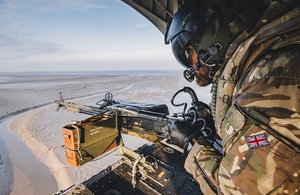RAF Chinook conducts airborne gunnery training in Lincolnshire
A Royal Air Force Chinook from RAF Odiham has been conducting live firing training at a range in Lincolnshire.

A Royal Air Force Chinook from RAF Odiham has been conducting live firing training at a range in Lincolnshire.
During the exercise, the Chinook fired twin M134 Miniguns and single M60D General Purpose Machine guns at a mix of purpose-built targets.
The firing is done by the onboard Weapons System Operators, who are required to conduct this training regularly to ensure they maintain their skills and safety qualifications. Firing from a moving helicopter is particularly difficult and the accuracy of the firing was assessed as part of the training. The training includes responses to various threat scenarios, such as self-defence when the aircraft is taking-off and landing.
After completing the daylight firing serials, the aircraft landed at RAF Coningsby to refuel and replenish the ammunition. It then completed the same training at night, with the crew using night vision goggles.
Operating the aircraft and airborne gunnery at night requires additional skills, especially when ambient light levels are low. Whilst operating over the sea on a dark night at 200 feet above the water, the crew have very few references outside of the aircraft with which to gauge their height or attitude.
Precision air-to-ground firing requires exceptional teamwork. The pilots must position the aircraft accurately and provide a stable platform from which to employ the guns. Red tracer rounds are used to gauge accuracy and are especially vivid at night as they leave long trails across the sky until they burn out.
Royal Air Force Chinooks conduct a wide variety of tasks from carrying troops and equipment, transporting injured service personnel from the battlefield to medical care and supporting wider-Government efforts in times of national crisis.
More recently, Royal Air Force Chinooks have been deployed to Estonia as part of the bilateral agreement between the Defence Ministers of Estonia and the UK. Whilst in Estonia they supported NATO’s enhanced forward presence in the region.